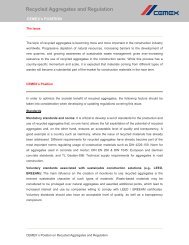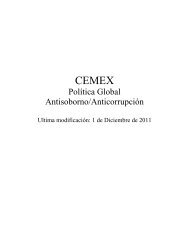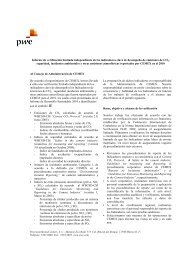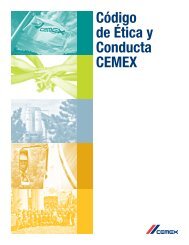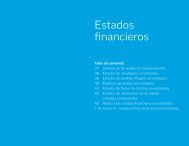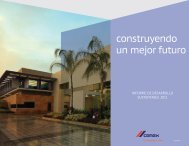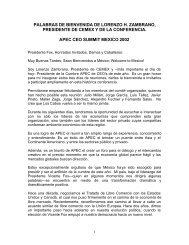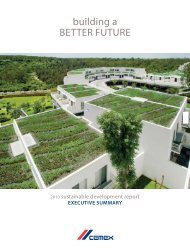building a STRONGER foundation - Cemex
building a STRONGER foundation - Cemex
building a STRONGER foundation - Cemex
Create successful ePaper yourself
Turn your PDF publications into a flip-book with our unique Google optimized e-Paper software.
CEMEX, S.A.B. DE C.V. AND SUBSIDIARIES<br />
Notes to the Consolidated Financial Statements – (Continued)<br />
As of December 31, 2010, 2009 and 2008<br />
(Millions of Mexican pesos)<br />
Under U.S. GAAP, CEMEX applies ASC 810, Consolidation (“ASC 810”). This topic addresses the consolidation of variable interest entities<br />
("VIEs"), which are defined as those that have one or more of the following characteristics: (i) entities in which the equity investment at risk<br />
is not sufficient to finance their operations without requiring additional subordinated financing support provided by any parties, including the<br />
equity holders; and (ii) the equity investors lack one or more of the following attributes: a) the ability to make decisions about the entity's<br />
activities through voting or similar rights, b) the obligation to absorb the expected losses of the entity, and c) the right to receive the expected<br />
residual returns of the entity. Among others, entities that are deemed to be a business according to ASC 810-10-15, Consolidation – Overall –<br />
Scope and Scope Exceptions, including operating joint ventures, need not be evaluated to determine if they are VIEs under ASC 810.<br />
Variable interests, among other factors, may be represented by operating losses, debt, contingent obligations or residual risks and may be<br />
assumed by means of loans, guarantees, management contracts, leasing, put options, derivatives, etc. A primary beneficiary is the entity that<br />
assumes the variable interests of a VIE, or the majority of them in the case of partnerships, directly or jointly with related parties, and is the<br />
entity that should consolidate the VIE. For the years ended December 31, 2010, 2009 and 2008, CEMEX has not identified any VIE that<br />
would require consolidation under U.S. GAAP other than those consolidated under MFRS.<br />
Accounting for Planned Major Maintenance Activities<br />
Under both MFRS and U.S. GAAP, CEMEX does not use the accrue-in-advance method of accounting for planned major maintenance<br />
activities considering that an obligation has not been incurred and therefore a liability should not be recognized.<br />
(p) Newly Issued Accounting Pronouncements under U.S. GAAP not Effective in 2010<br />
In October 2009, the FASB issued ASU 2009-13, Revenue Recognition (Topic 605): Multiple Deliverable Revenue Arrangements (EITF<br />
Issue No. 08 1, Revenue Arrangements with Multiple Deliverables) (“ASU 2009-13”). ASU 2009-13 amends ASC 650 25 to eliminate the<br />
requirement that all undelivered elements have vendor specific objective evidence of selling price (“VSOE”) or third party evidence of selling<br />
price (TPE) before an entity can recognize the portion of an overall arrangement fee that is attributable to items that already have been<br />
delivered. In the absence of VSOE and TPE for one or more delivered or undelivered elements in a multiple element arrangement, entities<br />
will be required to estimate the selling prices of those elements. The overall arrangement fee will be allocated to each element (both delivered<br />
and undelivered items) based on their relative selling prices, regardless of whether those selling prices are evidenced by VSOE or TPE or are<br />
based on the entity’s estimated selling price. Application of the “residual method” of allocating an overall arrangement fee between delivered<br />
and undelivered elements will no longer be permitted upon adoption of ASU 2009-13. Additionally, the new guidance will require entities to<br />
disclose more information about their multiple element revenue arrangements. ASU 2009-13 is effective for CEMEX prospectively for<br />
revenue arrangements entered into or materially modified beginning January 1, 2011. Early adoption is permitted. CEMEX expects that the<br />
adoption of ASU 2009-13 will not have a material impact on its consolidated financial statements.<br />
In December 2010, the FASB issued ASU 2010-28, Intangibles—Goodwill and Other (Topic 350): When to Perform Step 2 of the Goodwill<br />
Impairment Test for Reporting Units with Zero or Negative Carrying Amounts, a consensus of the FASB Emerging Issues Task Force (Issue<br />
No. 10-A) (“ASU 210-28”). ASU 2010-28 modifies Step 1 of the goodwill impairment test under ASC Topic 350 for reporting units with zero<br />
or negative carrying amounts to require an entity to perform Step 2 of the goodwill impairment test if it is more likely than not that a goodwill<br />
impairment exists. In determining whether it is more likely than not that goodwill impairment exists, an entity should consider whether there<br />
are adverse qualitative factors, including the examples provided in ASC paragraph 350-20-35-30, in determining whether an interim goodwill<br />
impairment test between annual test dates is necessary. The ASU allows an entity to use either the equity or enterprise valuation premise to<br />
determine the carrying amount of a reporting unit. ASU 2010-28 is effective for CEMEX beginning January 1, 2011. CEMEX expects that<br />
the adoption of ASU 2010-28 in 2011 will not have a material impact on its consolidated financial statements.<br />
F-79



